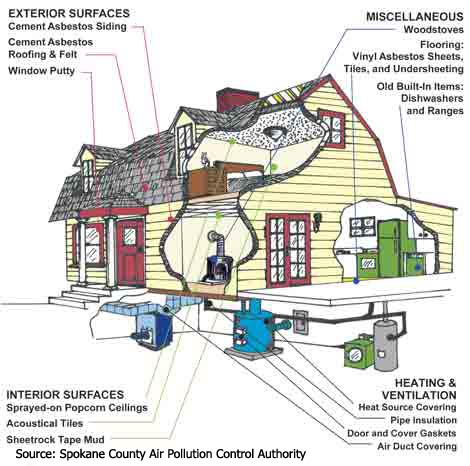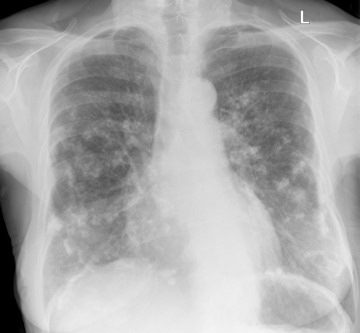What Is Asbestos Exposure About Biogarphy
Source(google.com.pk)Asbestos is a mineral that is made up of silicon, oxygen, hydrogen and other metal ions. These needle shaped fibers are so small that they cannot be seen unless the concentration in the air is very heavy. Asbestos is an excellent material for insulation because the fibers are strong, flexible and will not burn. The three most common forms of asbestos fibers are chrysolite, amosite and crocidolite. Because asbestos is such a tiny fiber, it needs to be attached to something. When asbestos fibers are mixed with other materials, it produces what is called an asbestos containing material.
.
Many industrial products are made of asbestos, including thermal insulation (pipe, block & cement); fireproofing acoustical texture products; textile and cloth products (asbestos gloves, blanket, etc.); spackling, patching & taping compounds; gaskets and packing, asbestos-cement pipe and sheet material, ceiling tiles, wall board, siding and roofing; friction materials (brakes & clutches). Asbestos materials had been used by the automotive industry, shipping industry and NASA for insulating the Space Shuttle.
The dust that is created from the manufacture, installation and eventual deterioration of asbestos materials releases asbestos in the air. Asbestos becomes a health hazard only when these materials crumble, fall apart, are damaged or ripped. When asbestos materials are damaged, fibers are released into the air, where they may stay suspended for long periods of time. Asbestos can then be inhaled and the fibers can lodge deeply in the lungs.
The Federal government placed a moratorium on the production of most asbestos products in the early 1970's, but these products continued to be installed through the late 1970's and even into the early 1980's. Asbestos cement pipe which would need to be cut, beveled, and grinded by pipe fitters had continued well into the late 1980s and sometimes the 1990s.
Commercial production of asbestos insulation began in 1879, and the first case of asbestos-related disease, described as "curious bodies" in the lungs was detected in 1899. The first cases of asbestosis and lung cancer attributable to asbestos exposure were diagnosed in the United States in 1935. The Congressional Library of Congress has had a book on the harmful effects of asbestos and its link to cancer causation as it discusses the analysis of work place illnesses on its shelves since it was published in 1939.
Most health information on asbestos has been derived from studies of workers who have been exposed to asbestos in the course of their occupation. Asbestos fiber concentrations for these workers were many times higher than those encountered by the general public. Although the risks associated with low-level non-occupational exposure are not as well established, the Environmental Protection Agency (EPA) concludes that there is no safe level of exposure to asbestos fibers.
This commentary reviews the research of Dr. Le Roy Upson Gardner conducted in 1942 that inhaled chrysotile fibers could induce malignant neoplasia in mice; and between 1951 and 1954, using cancer-insusceptible mice, yielded neoplasia risk ratio of 5.7 compared with control animals. The studies also showed that the primary effect of chrysotile is to cause epithelial proliferation in alveoli adjacent to bronchioles. Gardner had written letters and reports designating some of the mouse tumors as malignant and he attributed the tumors to inhaled chrysotile asbestos fibers, even though the mice had not developed asbestosis. Gardner had found in 1942 that the majority of the mouse tumors were truly malignant. Details are provided in a manuscript on the "Thirty Years of Asbestos Research of the Saranac Laboratory between the years 1928 and 1958" by Gerrit Schepers. These details are fairly clearly recorded in Dr. Gardner's handwritten notes (cited in the book noted above) because he did not publish these research findings in technical journals, for his work was performed on behalf of industrial sponsors, from whom he did not have permission to publish.
Asbestos in automobile brake linings may be a potential cause of cancer, a Wayne State University School of Medicine research team fears. Dr. Andrew Reeves, chief of the research team, said yesterday that overexposure to asbestos particles is known to be the cause of a number of lung diseases, including cancer. But what isn't known, he said, is whether use of the brakes releases harmful particles into the air.
ASBESTOS is used in brake linings, building materials and, to some extent, in the clothing industry. In addition to lung cancer, overexposure to asbestos may lead to asbestosis, a degenerative type of lung disease, and possibly to mesothelioma, a tumor of the lining of the chest cavity, or pleura.
Dr. Reeves said the asbestos industry denies, on good evidence, that asbestos released into the air from automobile brakes poses a health hazard because the high temperatures incurred in braking mean the asbestos has taken another form. "But the final word is not known," Dr. Reeves said, nothing that is not known yet what that form is and whether it presents any hazard to humans.
Seeking "the final word," Dr. Reeves and his research team are planning an experimental system that will simulate the mechanical action of brakes, heat the asbestos to 1,500 degrees Fahrenheit and blow the dust into chambers for inhalation by guinea pigs. The guinea pigs will then be
Read more...
The study investigates mortality from cancer and other diseases in a cohort of wives of asbestos cement workers in Casale Monferrato (northern Italy). The cohort comprised of 1,964 women after the exclusion of those with an occupational record in the asbestos cement industry. A woman's domestic exposure to asbestos was estimated according to their husbands' periods of employment in the asbestos plant. The occurrence of malignant mesotheliomas after domestic exposure to asbestos has been shown. Despite the well known association between asbestos and malignancies and the suggestions from case reports and case-control studies of mesotheliomas due to domestic exposure to asbestos only one cohort study has been published so far on mortality among family contacts of asbestos workers. In this study, except for pleural neoplasms, mortality among women with the opportunity for exposure to domestic asbestos was not statistically different from that expected for any of the causes of death considered.
All women reported to have a pleural cancer and all but two of those dying from lung cancer had been exposed for at least 10 years. In conclusion this study found a clear excess of mesotheliomas among wives of workers in the asbestos cement production industry. Our results are in agreement with the only similar study published before and confirm the importance of avoiding contamination of asbestos workers' homes
LIBBY, Mont. -- Yvonne Resch remembers thinking as a child that the vermiculite mine only added to the area's natural beauty -- its lights on Zonolite Mountain looked like a castle.
But the mine and its processing plants spewed asbestos over her town for more than 70 years, coating homes, schools and ball fields. Now her father, mother and two brothers are among many residents who suffer the coughing, hacking and wheezing of asbestos-related diseases, which have been blamed in more than 200 deaths since the late 1990s.
The Environmental Protection Agency took the unprecedented step this week of declaring Libby a federal public health emergency, vowing to finish a cleanup that has languished for nearly a decade.
The agency pledged at least $125 million to speed the work of going door-to-door, raising tents over contaminated homes, removing contaminated soil and vacuuming out attics and any other surface once contaminated by miners returning from work.
This article presents a historical analysis of published data regarding the exposure of brake mechanics to asbestos as a result of doing brake work. Concerns about this possible hazard were first raised in the late 1960s. This analysis focuses on 30 years of data collected during the brake repair event (e.g., a brake job) and 8-hour time-weighted average (TWA) personal samples. A brake job TWA represents the average concentration a mechanic experienced during brake servicing, rather than throughout the workday, and an 8-hour TWA represents the average airborne concentration of asbestos for the entire workday (which would involve brake work and other activities). Nearly 200 brake job and 8-hour TWA airborne asbestos samples were analyzed to assess how asbestos concentrations varied by type of vehicle serviced, country in which mechanics worked, time period, and brake-cleaning method. To facilitate comparisons, brake job TWAs were converted to estimated 8-hour TWAs using the durations and number of brake jobs performed per mechanic each day. Estimated and measured 8-hour TWAs for mechanics servicing automobiles and light trucks ranged from <0.002 to 0.68 f/cc, with a mean of 0.04 f/cc. In contrast, the 8-hour TWAs for mechanics servicing heavy trucks and buses ranged from 0.002 to 1.75 f/cc, with a mean of 0.2 f/cc, suggesting that these mechanics experienced higher daily asbestos exposures than automobile and light truck mechanics. Brake job and 8-hour TWAs for brake mechanics worldwide were found to be similar during the same time periods, and they were consistently below contemporaneous occupational health standards in the United States. The increased use of brake-dust control measures in some garages resulted in at least a 10-fold decrease in the TWA airborne concentrations of asbestos from the 1970s to the late 1980s.
Our goal in this brief and limited historical summary of asbestos-related diseases has been to bring the clinician up to date with the current status of this important medical and public health issue. The references will provide an information source for those who require more comprehensive knowledge.
What Is Asbestos Exposure Mesothelioma Lawyers 2013
 |
| What Is Asbestos Exposure Mesothelioma Lawyers 2013 |
 |
| What Is Asbestos Exposure Mesothelioma Lawyers 2013 |
 |
| What Is Asbestos Exposure Mesothelioma Lawyers 2013 |
 |
| What Is Asbestos Exposure Mesothelioma Lawyers 2013 |
 |
| What Is Asbestos Exposure Mesothelioma Lawyers 2013 |
 |
| What Is Asbestos Exposure Mesothelioma Lawyers 2013 |
 |
| What Is Asbestos Exposure Mesothelioma Lawyers 2013 |
 |
| What Is Asbestos Exposure Mesothelioma Lawyers 2013 |
 |
| What Is Asbestos Exposure Mesothelioma Lawyers 2013 |
Thanks for the nice blog. It was very useful for me. I'm happy I found this blog. Thank you for sharing with us,I too always learn something new from your post. GPW Law
ReplyDeleteWonderful illustrated information. I thank you about that. No doubt it will be very useful for my future projects. Would like to see some other posts on the same subject! Website
ReplyDeleteI high appreciate this post. It’s hard to find the good from the bad sometimes, but I think you’ve nailed it! would you mind updating your blog with more information? gpwlaw-wv.com/
ReplyDeleteI essentially discovered your site page and expected that would state that I have truly respected the experience of looking on the web diary sections. asbestos testing
ReplyDelete